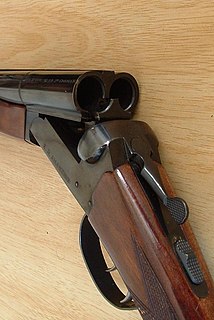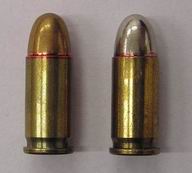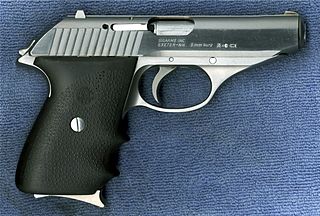
In firearms terminology, an action is the functional mechanism of a breech-loading weapon that handles the ammunition, or the method by which that mechanism works. Actions are technically not present on muzzleloaders, as all those are single-shot weapons with a closed off breech and the ammunition is manually loaded through the muzzle. Instead, the muzzleloader ignition mechanism is referred to as the lock,.

The Browning Hi-Power is a single-action, semi-automatic handgun available in the 9mm and .40 S&W calibers. It was based on a design by American firearms inventor John Browning, and completed by Dieudonné Saive at Fabrique Nationale (FN) of Herstal, Belgium. Browning died in 1926, several years before the design was finalized. The Hi-Power is one of the most widely used military pistols in history, having been used by the armed forces of over 50 countries. After 82 years of continuous production, the Hi-Power was discontinued in 2017 by Browning Arms, but it remained in production in some countries, under license.

A semi-automatic pistol is a type of repeating single-chamber handgun (pistol) that automatically cycles its action to insert the subsequent cartridge into the chamber (self-loading), but requires manual actuation of the trigger to actually discharge the following shot. As a result, only one round of ammunition is fired each time the trigger is pulled, as the pistol's fire control group disconnects the trigger mechanism from the firing pin/striker until the trigger has been released and reset.

The .380 ACP (9×17mm) is a rimless, straight-walled pistol cartridge developed by firearms designer John Moses Browning. The cartridge headspaces on the mouth of the case. It was introduced in 1908 by Colt, for use in its new Colt Model 1908 pocket hammerless semi-automatic, and has been a popular self-defense cartridge ever since, seeing wide use in numerous handguns. Other names for .380 ACP include .380 Auto, 9×17mm, 9mm Browning, 9mm Corto, 9mm Kurz, 9mm Short, and 9mm Browning Court. It should not be confused with .38 ACP.

.32 ACP is a centerfire pistol cartridge. It is a semi-rimmed, straight-walled cartridge developed by firearms designer John Browning, initially for use in the FN M1900 semi-automatic pistol. It was introduced in 1899 by Fabrique Nationale, and is also known as the 7.65×17mmSR Browning or 7.65 mm Browning Short.

The SIG Sauer P220 is a semi-automatic pistol. Designed in 1975 by the SIG Arms AG division of Schweizerische Industrie Gesellschaft, and produced by J. P. Sauer & Sohn, in Eckernförde; it is currently manufactured by both SIG Sauer companies: SIG Sauer GMBH, of Eckernförde, Germany; and SIG Sauer, Inc., of New Hampshire, United States.

The SIG Sauer P226 is a full-sized, service-type pistol made by SIG Sauer. This model is sold with a choice of four chambers to choose from: the 9×19mm Parabellum, .40 S&W, .357 SIG, or .22 Long Rifle. It has essentially the same basic design as the SIG Sauer P220, but is developed to use higher capacity, double stack magazines in place of the single stack magazines of the P220.

Hi-Point Firearms, also known as Strassell's Machine, Inc, is an American firearms manufacturer based in Mansfield, Ohio. All of their firearms are manufactured in the United States, in several different locations in Ohio.

In American English, a pocket pistol is any small, pocket-sized semi-automatic pistol, suitable for concealed carry in either a coat, jacket or trouser pocket.

The Sauer 38H or often just H was a small semi-automatic pistol made in Nazi Germany from 1938 until just after the end of World War II by J. P. Sauer & Sohn, then based in Suhl, Germany. The "H" in the model number is short for "hahn", referring to the internal hammer of the firing mechanism.

Locked breech is the design of a breech-reloading firearm's action. This is important in understanding how a self-reloading firearm works. In the simplest terms, the locked breech is one way to slow down the opening of the breech of a self-reloading firearm when fired. The source of power for the movement is recoil.

J. P. Sauer und Sohn GmbH is a manufacturer of firearms and machinery and is the oldest firearms manufacturer still active in Germany. The products of this company are frequently referred to as Sauer.

The Hi-Point Model JCP is a blowback operated semi-automatic pistol chambered for the .40 S&W round.

A handgun is a short-barrelled firearm that can be held and used with one hand. The two most common handgun sub-types in use today are revolvers and semi-automatic pistols, although other handguns like machine pistols and derringers also see infrequent usage.

The SIG Sauer P230 is a small, semi-automatic handgun chambered in .32 ACP or .380 Auto. It was designed by SIG Sauer of Eckernförde, Germany. It was imported into the United States by SIGARMS in 1985. In 1996 it was replaced by the model P232.

FN HP-DA is a 9mm semi-automatic pistol developed by Belgian Fabrique Nationale arms factory in Herstal. In North American markets, it was marketed as Browning BDA and is also referred to as Browning DA and Browning Hi-Power BDA.

The Astra A-100 is a Spanish double-action/single-action semi-automatic pistol that was manufactured by Astra-Unceta y Cia SA beginning in 1990. It was distributed in the United States by European American Armory (EAA). The A-100 is also known as the "Panther" as imported into the United States by Springfield Armry, and some specimens have this roll-marked on the left of the slide. The A-100 design is a further development of Astra's earlier A-80 and A-90 models. The A-80 was originally patterned after the SIG P220.

The SIG Sauer P227 is an American-designed and produced semi-automatic pistol which was introduced in 2013 and discontinued in 2019. The P227 introduced a double-stack .45 ACP caliber handgun into the SIG Sauer lineup. It was introduced along with the P224.

The SIG Sauer P365 High-Capacity Micro-Compact is a polymer frame striker-fired semi-automatic pistol manufactured by SIG Sauer and intended for everyday carry. It is chambered in 9×19mm Parabellum and is rated for +P ammunition while utilizing offset double-stack magazines. It is offered with Tritium XRAY3 Day/Night Sights and two 10-round magazines; one flush fit and the other with an extended finger tab. The P365, which replaced the P290RS, is produced in Newington, New Hampshire.

The SIG Sauer System is a type of action found in self-loading handguns. It is a refinement of designs based on the work of both John M. Browning and Charles Petter which began with the Browning Model 1910, progressed to the French Model 1935A, and later the SIG P210 handgun. This action first appeared in the United States on the Browning BDA .45 ACP caliber handgun around 1975. It represents a design which optimizes the cost of production of handguns while instilling high levels of accuracy and dependability. It is the basis for several SIG Sauer, Inc. designs which have been widely adopted for police, military, and civilian use and is the action used in the M17 and M18 sidearms of the United States Armed Forces. It has become a highly copied design found in many parts of the world today.






















